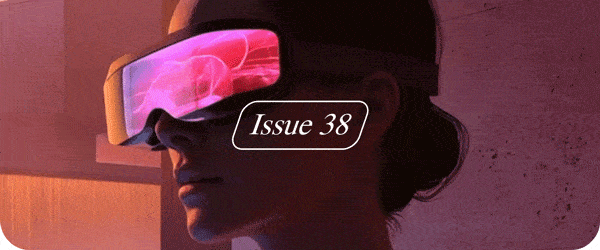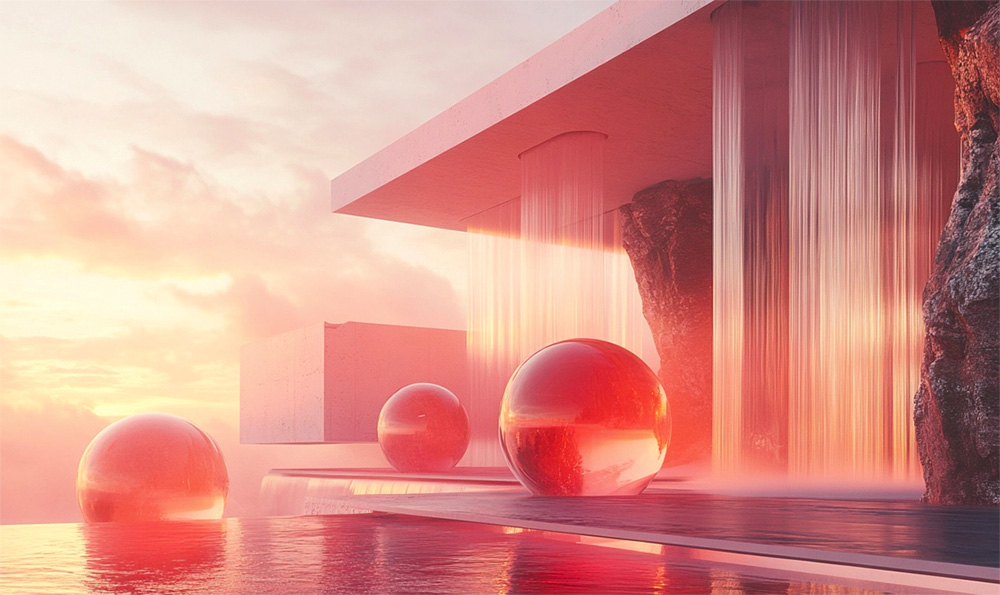

Turning ourselves
inside-out
inside-out
AI and the imagination
In a world increasingly defined by the interplay of technology and human consciousness, we find ourselves poised at an extraordinary precipice. Artificial intelligence, extended reality (XR), and biofield technologies, such as EEG wearables and brain implants, now swirl together in a convergence that defies traditional boundaries between mind and matter.
What happens when the imagination itself becomes a canvas we can step into, inhabit, and share? The proposition is tantalizing: a near future where we turn ourselves inside-out, where the mind’s innermost visions are no longer confined to the domain of dreams or psychedelic visions but are woven into the very fabric of reality.
This article delves into the growing potential of AI, XR, and biofield tech to unleash the human imagination. These technologies, rather than remaining distinct tools, are poised to form a symbiotic ecosystem, one that not only renders our imaginations palpable but offers a mind-expanding journey into worlds shaped by collective creativity. The interface of AI and the imagination promises more than new forms of entertainment or productivity; it beckons toward a reconceptualization of reality itself—a psychedelic shift in how we perceive and experience the world.
What happens when the imagination itself becomes a canvas we can step into, inhabit, and share? The proposition is tantalizing: a near future where we turn ourselves inside-out, where the mind’s innermost visions are no longer confined to the domain of dreams or psychedelic visions but are woven into the very fabric of reality.
This article delves into the growing potential of AI, XR, and biofield tech to unleash the human imagination. These technologies, rather than remaining distinct tools, are poised to form a symbiotic ecosystem, one that not only renders our imaginations palpable but offers a mind-expanding journey into worlds shaped by collective creativity. The interface of AI and the imagination promises more than new forms of entertainment or productivity; it beckons toward a reconceptualization of reality itself—a psychedelic shift in how we perceive and experience the world.
1
The Psychedelic Potency
of Imagination Tech
of Imagination Tech
Psychedelic experiences have long shown us the mind’s capacity to create vivid, seemingly boundless realms. These are worlds defined not by external logic but by the logic of the psyche: fluid, symbolic, and often revelatory. With the development of technologies that can read and respond to our mental states in real time, such as EEG wearables and brain-computer interfaces, we may be inching toward a future where these “inner landscapes” can be projected into sharable, navigable virtual realities. In this light, the imagination itself becomes a digital material—a substance that can be sculpted, programmed, and explored.
Whereas psychedelics, whether natural or synthetic, dissolve the boundaries of self-perception chemically, AI and XR aim to accomplish something equally radical by technological means. Imagine slipping into a reality that adapts to your innermost thoughts and feelings, where the very walls shimmer with the architecture of your dreams, and where your surroundings shift to mirror the depths of your psyche. In this world, we encounter an echo of what Aldous Huxley described as “Mind at Large”—an expansive consciousness limited not by physics but by our capacity to imagine.
Whereas psychedelics, whether natural or synthetic, dissolve the boundaries of self-perception chemically, AI and XR aim to accomplish something equally radical by technological means. Imagine slipping into a reality that adapts to your innermost thoughts and feelings, where the very walls shimmer with the architecture of your dreams, and where your surroundings shift to mirror the depths of your psyche. In this world, we encounter an echo of what Aldous Huxley described as “Mind at Large”—an expansive consciousness limited not by physics but by our capacity to imagine.
2
Artificial Intelligence:
The Imagination’s Co-Creator
The Imagination’s Co-Creator
AI’s role in this emerging ecosystem is to act as an imagination amplifier. While human creativity offers the spark, AI provides the medium by which ideas can be scaled, refined, and transformed into interactive experiences. Consider the latest developments in generative AI, where algorithms now produce highly sophisticated art, music, and even architecture. But the true frontier lies in adaptive AI systems capable of interfacing with the imagination directly, not merely as passive translators but as active, co-creative participants.

Imagine an AI that reads your neural activity through a brain implant and understands your emotional and conceptual patterns. It then responds in real time, generating visual, auditory, or even tactile experiences that resonate with your mental state. This would represent a partnership between human and machine intelligence, one in which AI becomes not merely an observer or tool but a dynamic collaborator in the imaginative process. This idea could evolve to include an “emotionally intelligent” AI capable of sensing and amplifying our subtlest whims or deepest insights, potentially allowing us to enter a new kind of dialogue with our own consciousness.
Such an AI-driven amplification of the imagination could be likened to a lucid dream in which our thoughts and desires are given form and substance, yet remain malleable, shifting in response to our evolving emotional landscape. Rather than imposing structure on the imagination, AI would act as a facilitator, allowing users to explore fluid, evolving worlds that reflect their inner states. This could be therapeutic, creative, and deeply immersive—a technology with psychedelic potential that brings us into new and meaningful dialogue with our subconscious mind.
Such an AI-driven amplification of the imagination could be likened to a lucid dream in which our thoughts and desires are given form and substance, yet remain malleable, shifting in response to our evolving emotional landscape. Rather than imposing structure on the imagination, AI would act as a facilitator, allowing users to explore fluid, evolving worlds that reflect their inner states. This could be therapeutic, creative, and deeply immersive—a technology with psychedelic potential that brings us into new and meaningful dialogue with our subconscious mind.
3
Extended Reality (XR):
Merging Mind and Environment
Merging Mind and Environment
While AI provides the intelligence, XR technologies serve as the physical vessel that brings imaginative worlds to life. XR—a term encompassing augmented, virtual, and mixed reality—allows for the seamless blending of physical and digital worlds, creating spaces where imagined elements can coexist with physical ones. In a sense, XR serves as the stage upon which the drama of the imagination plays out, allowing for increasingly immersive experiences that extend beyond the limitations of traditional screens and into our lived environments.
Through a combination of headsets, holograms, and augmented reality lenses, XR promises to dissolve the distinction between what is “in here” and what is “out there.” Imagine walking through a familiar cityscape, only to see it overlaid with images from your own memories or dreams, creating an otherworldly fusion of past, present, and imagination. Buildings shift in size or design based on your mood, and streets transform into rivers or forests at will. In this XR-enhanced landscape, reality becomes a canvas, painted with the hues of your consciousness.
Yet, the promise of XR goes beyond aesthetics. XR could enable shared spaces where the personal visions of multiple users merge, creating a collaborative dreamscape. Here, friends or strangers could join one another in realms born of individual imaginations, sharing the raw, unfiltered language of dreams. In such a world, communication itself might transcend words, becoming a form of direct empathy as users witness and even experience one another’s internal realities.
Through a combination of headsets, holograms, and augmented reality lenses, XR promises to dissolve the distinction between what is “in here” and what is “out there.” Imagine walking through a familiar cityscape, only to see it overlaid with images from your own memories or dreams, creating an otherworldly fusion of past, present, and imagination. Buildings shift in size or design based on your mood, and streets transform into rivers or forests at will. In this XR-enhanced landscape, reality becomes a canvas, painted with the hues of your consciousness.
Yet, the promise of XR goes beyond aesthetics. XR could enable shared spaces where the personal visions of multiple users merge, creating a collaborative dreamscape. Here, friends or strangers could join one another in realms born of individual imaginations, sharing the raw, unfiltered language of dreams. In such a world, communication itself might transcend words, becoming a form of direct empathy as users witness and even experience one another’s internal realities.
4
Biofield Tech:
The Body as Interface
The Body as Interface
Biofield technologies, from EEG wearables to invasive brain implants, constitute the final, essential layer in this technological trinity. By allowing direct neural interfaces with AI systems and XR platforms, biofield tech provides the means for our bodies and minds to directly influence—and be influenced by—the digital world. This is where the boundary between self and technology begins to dissolve, where our bodies become conduits for imagination, and where the phrase “mind over matter” takes on an almost literal truth.
Biofield tech also opens up unprecedented opportunities for introspection and self-understanding. Imagine wearable devices that track emotional fluctuations, capturing subtle shifts in mood and intention that would otherwise go unnoticed. This data could then be fed into an AI that responds accordingly, adjusting the user’s XR environment in real time to create a world that reflects their emotional reality. Through such technologies, we could enter deeply immersive states where the external world aligns with the inner self, offering a level of coherence between mind and environment that borders on the mystical.
Moreover, biofield tech could act as a bridge between the conscious and unconscious mind. As we become more attuned to our neural rhythms and emotional patterns, we may gain new insights into the nature of thought, memory, and identity itself. This would represent not just a technological advancement but a profound shift in self-perception, as individuals begin to experience the interplay between mind and reality in ways previously relegated to the realm of mysticism or psychedelic experience.
Biofield tech also opens up unprecedented opportunities for introspection and self-understanding. Imagine wearable devices that track emotional fluctuations, capturing subtle shifts in mood and intention that would otherwise go unnoticed. This data could then be fed into an AI that responds accordingly, adjusting the user’s XR environment in real time to create a world that reflects their emotional reality. Through such technologies, we could enter deeply immersive states where the external world aligns with the inner self, offering a level of coherence between mind and environment that borders on the mystical.
Moreover, biofield tech could act as a bridge between the conscious and unconscious mind. As we become more attuned to our neural rhythms and emotional patterns, we may gain new insights into the nature of thought, memory, and identity itself. This would represent not just a technological advancement but a profound shift in self-perception, as individuals begin to experience the interplay between mind and reality in ways previously relegated to the realm of mysticism or psychedelic experience.
5
Toward a
Symbiotic Reality
Symbiotic Reality
The synthesis of AI, XR, and biofield tech points to an imminent future where reality is no longer singular but plural—a dynamic matrix of shared and individual experiences shaped by the mind. Such a future invites questions that border on the metaphysical: What happens to the notion of “objective reality” when our subjective states can manifest in the world around us? Does the boundary between self and other begin to blur as our minds, and those of others, are laid bare? And most fundamentally, can technology lead us not just into new worlds but into new ways of being?
Perhaps the most psychedelic aspect of this technological evolution lies in its capacity to dissolve the rigid dualities that have long governed our experience—mind versus body, self versus other, imagination versus reality. By allowing the imagination to influence and even create our lived environments, these technologies offer a glimpse of a world in which human consciousness itself is the fundamental creative force, capable of shaping reality from the inside out.
The convergence of AI, XR, and biofield tech promises more than an expansion of what is possible. It represents a turning inside-out of the self, a radical merging of internal and external worlds. This is a future where the imagination is no longer confined to the mind’s eye but becomes a realm we can walk through, touch, and share—a psychedelic technology that, rather than transporting us to other worlds, reveals the boundless worlds within. In turning ourselves inside-out, we might just discover that the imagination is not merely a tool for personal creativity but the blueprint of an expanded reality, one that invites us all to explore and co-create together.
Perhaps the most psychedelic aspect of this technological evolution lies in its capacity to dissolve the rigid dualities that have long governed our experience—mind versus body, self versus other, imagination versus reality. By allowing the imagination to influence and even create our lived environments, these technologies offer a glimpse of a world in which human consciousness itself is the fundamental creative force, capable of shaping reality from the inside out.
The convergence of AI, XR, and biofield tech promises more than an expansion of what is possible. It represents a turning inside-out of the self, a radical merging of internal and external worlds. This is a future where the imagination is no longer confined to the mind’s eye but becomes a realm we can walk through, touch, and share—a psychedelic technology that, rather than transporting us to other worlds, reveals the boundless worlds within. In turning ourselves inside-out, we might just discover that the imagination is not merely a tool for personal creativity but the blueprint of an expanded reality, one that invites us all to explore and co-create together.


Written by Robert Scoble • Read online

Update your email preferences or unsubscribe
© 2024 Unaligned
228 Park Ave S, #29976, New York, New York 10003, United States
© 2024 Unaligned
228 Park Ave S, #29976, New York, New York 10003, United States